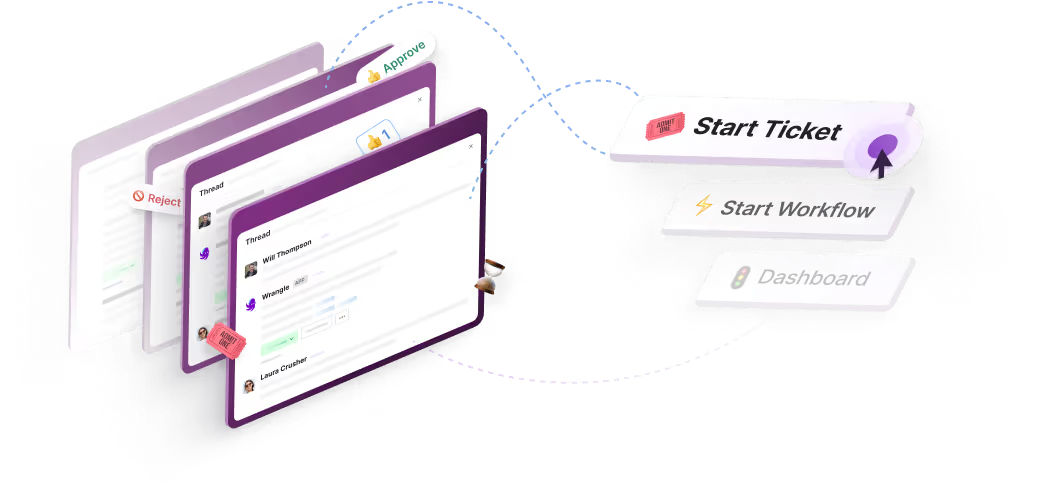Automating IT Ticketing with Advanced Workflows
It's time to automate your common IT workflows


IT managers ensure the business is running efficiently, keeping employees stocked with machines, software, and security. In the past, IT managers could always work with colleagues face to face, but in today's hybrid workplace, we must work across time zones and continents, increasing the need for automation and virtual communication.
Many IT managers rely on help desks and IT ticketing software to respond to a variety of tickets, including software questions, reports of an outage, or requests for new hardware. Traditional ticketing systems can collect issues, but they aren’t always good at helping you manage and prioritize. Furthermore, ticketing tools don’t provide the kind of task, approval, and communication management needed to complete the request from start to finish.
The future of IT ticketing is combining traditional ticketing with intake forms and workflow automation. You can even bring ticketing directly into your daily communication tools like Slack. What might a more advanced IT ticketing process look like? Envision a process that:
1) is managed in a platform your employees are already using every day
2) standardizes the ticketing process
3) automatically routes tickets to the right resource
4) keeps all stakeholders in the loop throughout the life cycle of the request.
Let’s dive deeper into each category to learn how the ticketing process could be fully automated.
1. Bring ticketing into the platform your employees already use every day
An employee has a request that needs to be addressed with someone from the IT team. In the past, the employee would log in to an external application to create a ticket. This means training on a separate tool, additional logins and seats, and hours dedicated to selecting and managing the platform. A more advanced IT ticketing tool lives where your employees spend their time. Imagine that the ticket can be created and managed inside of Slack.
2.Use intake forms to standardize the process
The employee’s request to open a ticket kicks off an intake process. Imagine an intake form that asks a series of questions and collects all the relevant data standardizing the ticket so that the IT manager has the information needed to act on the request reducing the back-and-forth between the requester and the requestee.
3. Automate the intake form with workflows
When IT has automated an intake form with a workflow, the employee ticket can be routed based on conditional logic and business rules. A high-priority request might be routed directly to a VP, whereas a lower-priority request might sit in the backlog until a team member has the bandwidth to resolve the ticket. Workflows can also ensure that all the sub-work is tracked and completed for every ticket.
4. Keep teams informed when the status of a request changes
When the IT manager is working on a request, she is frequently pinged for a status update. IT ticketing solutions should automatically keep requesters in the loop by transparently communicating via chat whenever the status of the request is updated.
Where might you apply a process like this in the real world? Here are four examples you can start automating:
Employee Onboarding
When a new hire starts, IT does a lot of the heavy lifting. One of the most common tasks is getting a new machine into their hands before the start date. Instead of manually going through a checklist, IT teams can set up a workflow that a hiring manager can access in Slack. The workflow could house a series of steps and continue throughout the onboarding process. The hiring manager might start a workflow request when the offer is accepted. A ticket would automatically be created and routed to the appropriate IT manager. As the onboarding process continues, each step would automatically progress and inform the stakeholders of the status via Slack DMs and in-channel updates. You might have a step for shipping hardware, creating accounts for critical internal systems, and even a step to hand over the onboarding process to a different team when the IT tasks are completed.
Access Request Workflow
One of the IT Managers' most common requests is granting access to company applications. As teams have embraced remote work, the volume of applications we use has increased exponentially. Workflows can help manage the process and ensure that approvals are clear and logged. Using access requests in a workflow helps speed up the process and provides a clear audit trail in the event of a security breach giving you a detailed history of every request. Integrating the workflow with Slack keeps everyone on the same page with real-time updates.
Change Request Workflows
IT managers are frequently responding to an assortment of change requests that must be reviewed, prioritized, discussed, and approved. Managers must evaluate the urgency of the business need and find ways to de-risk the request. The change request provides a standardized process to help with the evaluation proposal for the change. Workflow automation can ensure that the request is logged and the IT manager has all the information she needs to make an informed decision about whether or not to proceed with the change. A holistic platform like Wrangle can even bring the approval process directly into the workflow, streamlining the process. Similar to access requests, an audit trail can be maintained so that if a mistake occurs, there is clear accountability.
Security Review Workflows
One of the most important roles of an IT manager is to ensure the security of company hardware and data. During procurement, IT may be required to evaluate a potential system and determine whether it meets the security requirements. Often these vendor contracts represent investments of thousands to millions of dollars. A mistake could lead to a significant misstep that impacts budget and data security.
You can also use automated workflows and ticketing to maintain the security of your existing vendors. For example, your compliance team might require a partner to respond to a periodic security questionnaire on their security procedures. Automation can standardize the request so that the process occurs without fail at a set time interval.
Workflows remove some of the risks by ensuring standardized processes that include the correct approvers and maintain the audit trail of decision-making.
A Better Way to Automate IT Ticketing
Wrangle brings ticketing, workflows, and standardization to the IT manager with an automated platform that is built to work with Slack. Collect, respond, track, and resolve tickets in the platform your business uses most.
Automating your processes with Wrangle means building transparency and efficiency into your task management. IT teams can bring ticketing directly into their Slack channels with powerful workflow automation that routes work to the appropriate resource and makes sure nothing slips through the cracks.
Wrangle's no-code workflow builder allows you to apply standardization, automation, and audit tracking to any IT process.

- Try Wrangle free for 14 days
- Turn messages into trackable tickets
- Build a scalable help desk



Turn Slack into a productivity powerhouse with Wrangle
Create a scalable helpdesk in Slack. Automatically turn messages into trackable tickets and provide faster, more transparent service to your colleagues and customers with Wrangle — Try it free!





